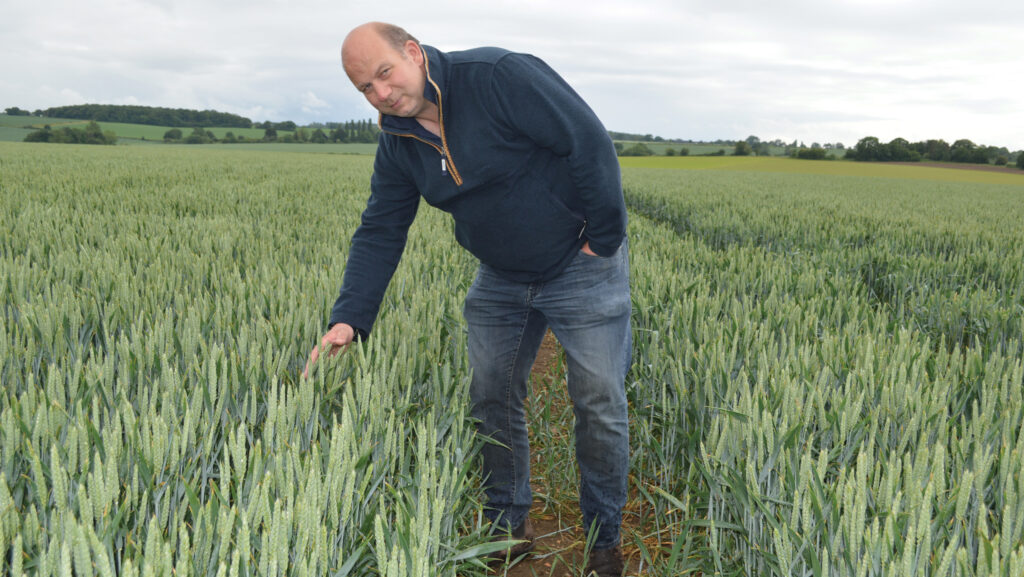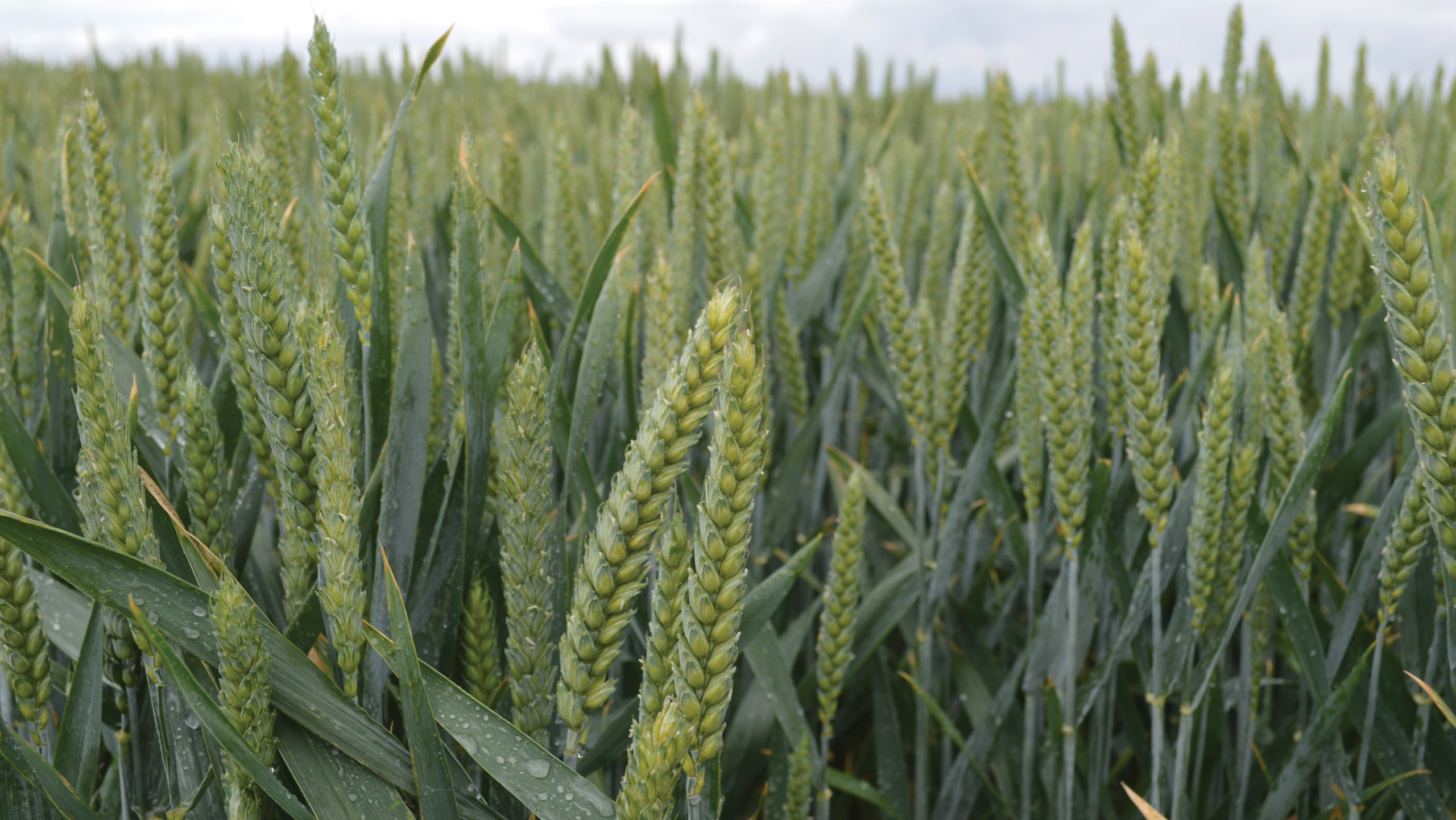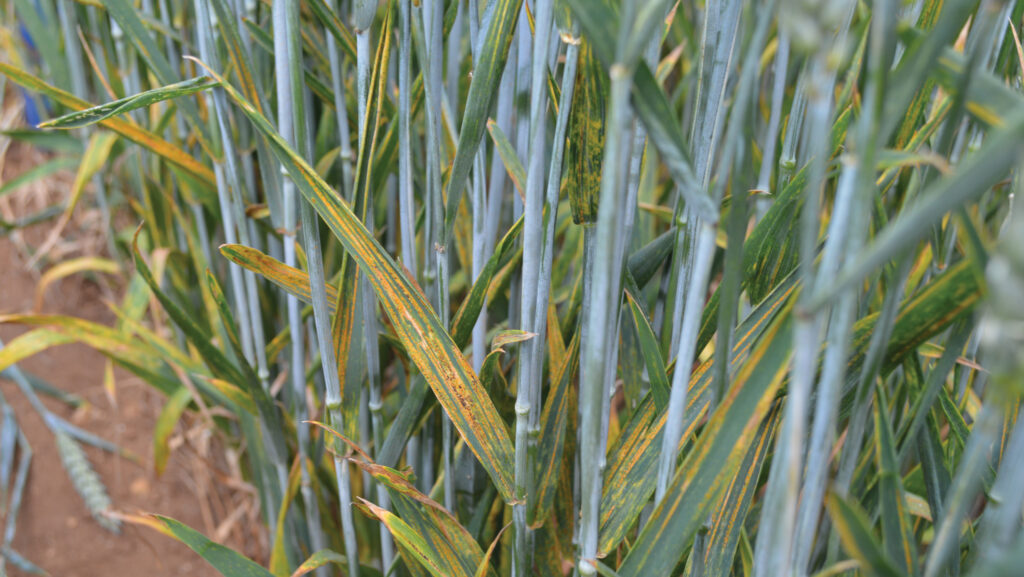Why Essex grower is expanding Scope wheat area this autumn
 Jeremy Durrant © David Jones
Jeremy Durrant © David Jones Essex grower Jeremy Durrant is so impressed with the new top-yielding feed winter wheat variety Scope that it will take up a quarter of his 500ha winter wheat area next season.
The variety was grown across 24ha last season on the heavy land farm, and out-yielded the 10.1t/ha farm average across first and second wheats by 1.7t/ha.
“The variety Scope looks to be one of the best we are growing this season, and it will be one of our main varieties next season and take up about 25% of our wheat area,” Jeremy says.
See also: Bedford grower assesses new varieties to replace Extase
He says the farm was given seed of a coded variety for the 24ha, and did not know it was Scope until halfway through the season.
It looked good throughout the growing season, he says, and outperformed Dawsum, which has been a mainstay variety on the farm.
Feed wheats
The farming business focuses on Group 4 feed wheats, as historically milling wheats have struggled in dry springs on the north-west Essex farm owing to difficulty getting nitrogen fertiliser into the crops to produce high-protein grain.

© David Jones
At harvest 2024, the 24ha of Scope yielded 11.8t/ha compared with 29ha of Dawsum at 10.5t/ha, both drilled on September 25 after winter beans and on similar soils, and receiving similar treatments.
It was that 1.3t/ha yield gap that made him so positive for the variety, as well as the comparison with the farm’s 10.1t/ha average yield.
Scope, from breeder KWS, entered the AHDB Recommended List in December last year with the highest fungicide-treated yield of 108%, above Champion at 107% and well ahead of Dawsum at 103%, showing good yields across all regions but especially the West (111%).
First and second wheats generally show average yields above 10t/ha on the mainly Hanslope series heavy clay soils.
Jeremy manages 1,000ha of arable land for EW Davies Farms at The Hydes, Thaxted, near Saffron Walden.
A quarter of the farm’s 500ha of wheat is grown for seed, with the rest grown commercially. The farm also grows winter and spring barley, winter and spring oats, spring barley, sugar beet, maize and herbal leys.
Favourite winter wheat varieties on the farm include older ones such as Insitor and Kerrin, which is no longer on the RL. Jeremy says these varieties have been the most consistent over the years as they don’t produce excess biomass and focus on producing good, big wheat ears and good grain weights.
This season
For the current season the variety line-up includes these two older varieties, newer varieties such as Scope, Dawsum and Redwald, and the milling variety Vibe, grown for seed.
Comparing the Scope and Dawsum crops last season, Jeremy says they looked very similar throughout the year until it came to harvest.
“Both varieties looked like producing a 12t/ha crop, and the only difference was when the combine went in the field and the yield of Dawsum fell away,” he says.
Both crops had the farm’s standard nitrogen approach of 230kg/ha in a three-way split, and a little-and-often five-spray fungicide treatment, including a T1-1/2.
Yellow rust is the biggest yield threat on the farm, but the little-and-often fungicide approach keeps the disease under control. Scope scores a 7 for yellow rust resistance against Dawsum’s 9 on a 1-9 scale, with 1 being very susceptible and 9 showing good resistance.
This season, many leading feed wheat varieties have been affected by a new race, or a mutation of an old race, of yellow rust which has overcome a key Yr15 resistance gene. Those affected include popular hard-milling feed types such as Dawsum, Champion, Typhoon, Beowulf and others.

A new race of yellow rust has affected several varieties © David Jones
Independent experts say Scope has been affected by this new race, but not as badly as Champion or Dawsum, while KWS says Scope has seen moderate levels of the disease this year.
The AHDB is assessing the yellow rust situation, and the disease rating of those varieties affected could be lowered.
Next season, Scope and Insitor will likely be the farm’s leading varieties, covering about 125ha each, with the area of Dawsum falling back.
This season, Jeremy has 74ha of Scope in the ground including a 30ha block of a commercial crop as a first wheat, and two seed crop blocks – 20ha as a first wheat and 24ha as a second wheat.
“The variety looks like one that suits the farm, and some went in at the end of October after maize in difficult wet conditions and now looks as good as any other variety on the farm,” he says.
The growth habit of Scope mirrors Insitor and Kerrin, giving not too much early growth, and does not over-tiller. Jeremy aims for 500-600 ears/sq m at harvest, with plenty of grain sites and heavy grains.
This season’s winter wheat crops on the farm have struggled after a wet autumn and winter which led to shallow-rooted crops, and the wet weather delayed an early spring application of nitrogen designed to help the crops recover.
Jeremy feared the worst in April with many wheat crops struggling, but 30mm of rain in late May has helped, and he now hopes for reasonable yields in the region of 9t/ha.
Trade views
Scope could become the leading winter wheat variety on farms in the next two years due to its high yield and good all-round disease resistance, says Matt Shand, head of arable at Wynnstay.
The seed supplier, based in the Welsh Borders, operates in areas where feed wheats largely predominate such as the west of England including the South West and into Wales, and also across to Yorkshire and Lincolnshire.
Matt sees Scope as “the new, exciting top of the RL feed variety and within two years will probably become the main wheat on farms”.
“It will take a large slot in our portfolio and most likely replace another feed wheat which may be slightly older or no longer as popular in the market,” he says.
Matt first saw Scope in autumn 2023 and was attracted by its high yields in both the East and West regions, its stiff straw and good disease resistance.
“In my opinion, we should choose varieties with a minimum AHDB rating of 6 for septoria and 8 for standing power,” he says.
Scope is one of few Group 4 wheats to achieve these scores, and combines that with a high specific weight of 78.9hl/kg, he adds.
The variety is one of the stiffest strawed varieties with an 8 for straw stiffness without using a plant growth regulator, along with other hard-milling feed wheat varieties Beowulf, Oxford, Dawsum and Costello, and the soft-milling feed variety Blackstone.
Scope’s 6.5 rating for septoria resistance compares with Dawsum’s 6.3, Beowulf’s 6.6 and Champion’s 7.6, with other hard-milling feed varieties at 6 or above including Insitor, Oxford, Graham, Typhoon and Wolverine, and soft-millers Redwald, Hexton and Zealum.
He points out that about half the certified seed market is in Group 4 feed wheats where the key is high yields, strong disease resistance and a good specific weight, and Scope looks to have met those key criteria.
James Webster-Rusk, senior agribusiness analyst at the Anderson Centre, adds to that positive impression by pointing out Scope’s consistency season to season.
“This is particularly important during challenging years with high weather stress, where variety traits such as specific weight are really tested,” he says.
James adds that in January to April this year there was less rain than in the same period of the very dry year of 1976, making 2025 the driest since 1964 for the same months.
In addition, he says some Group 1 milling wheat growers are moving to Group 4 feed wheats, attracted by their greater consistency and lower inputs.
Group 1 wheats have declined from a peak of 29% of the UK wheat area down to 24% last season, while Group 4 varieties have taken a greater share, increasing from 39% in the period 2020-22 to 48-49% in 2023-24, he adds.
Breeder’s view
Scope is the highest yielding winter wheat variety on the current RL, and brings new genetics to UK growers, as one of its parents is the German-bred Informer which is a very successful continental European variety.
Olivia Bacon, KWS UK product manager for wheat, says it is the best performing Group 4 hard-milling feed wheat for early sowings and also can be drilled through to the end of January.
In addition to its top yield, the variety has a similar very stiff straw strength to Dawsum and similar ripening maturity while giving good disease resistance – scoring 6.5 for septoria, 6 for brown rust and 7 for yellow rust.
Its high specific weight of 78.9kg/hl is beaten by only two other KWS wheats – Costello and Dawsum – among the RL’s hard-milling feed types.
For many growers a key attribute could be its resistance to orange wheat blossom midge, which Dawsum does not have.
There should be enough seed to account for about 6.5% of the certified seed market for drilling this autumn.
Hard-milling feed winter wheat varieties compared |
||||||
| Scope | Dawsum | Champion | Beowulf | Insitor | Graham | |
| Fungicide-treated yield | 108% | 103% | 107% | 105% | 105% | 103% |
| Untreated yield | 85% | 89% | 86% | 85% | 75% | 86% |
| Disease resistance | ||||||
| Yellow rust* | 7 | 9 | 8 | 9 | 3 | 7 |
| Brown rust* | 6 | 7 | 5 | 4 | 5 | 5 |
| Septoria tritici* | 6.5 | 6.3 | 7.6 | 6.6 | 6.5 | 6.5 |
| Agronomic features | ||||||
| Resistance to lodging (no PGR)* | 8 | 8 | 7 | 8 | 6 | 7 |
| Ripening (days +/-Skyfall) | +1 | +1 | 0 | +2 | +1 | -1 |
| Specific weight (kg/hl) | 78.9 | 79.9 | 75.6 | 78.5 | 78.8 | 77.8 |
| *On a scale of 1-9, with 9 showing the characteristic the most | ||||||
